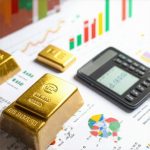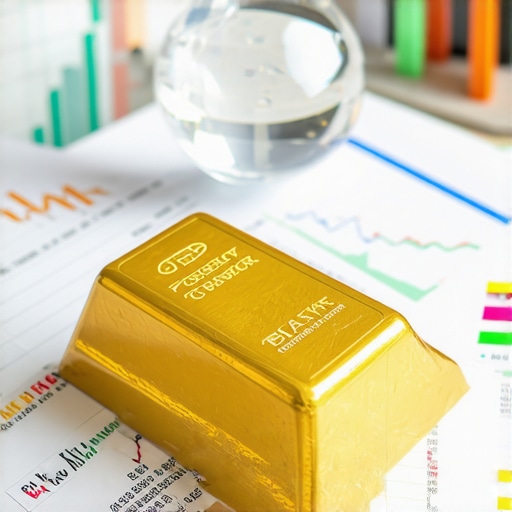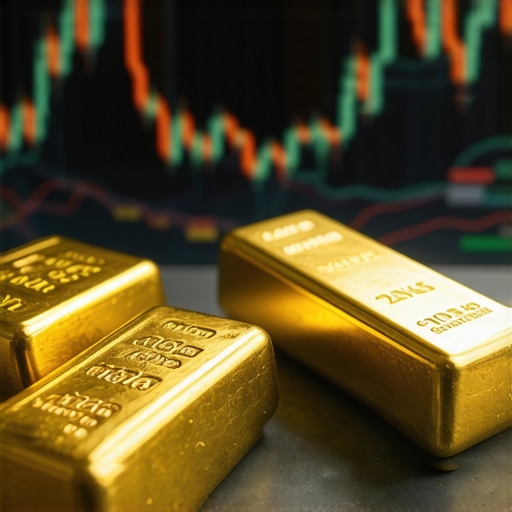Peering Into the Future: Why 2025 Is a Crucial Year for Gold Prices
As we approach 2025, investors worldwide are increasingly focused on the trajectory of gold prices. Beyond mere speculation, understanding the complex economic drivers behind these movements is essential for informed decision-making. Gold, long revered as a safe haven, interacts dynamically with global economic conditions, monetary policies, geopolitical tensions, and inflationary pressures. This article delves deep into these factors, offering expert analysis to illuminate what might lie ahead for gold’s market value.
Economic Currents Steering Gold’s 2025 Trajectory
Gold’s price is intricately linked to several macroeconomic variables. One primary driver is inflation expectations. With central banks worldwide navigating post-pandemic recovery while battling inflation spikes, gold often becomes a preferred hedge against currency devaluation. For example, during periods of rising inflation in the late 1970s, gold prices surged dramatically as investors sought safety.[IMF World Economic Outlook] Similarly, in 2025, persistent inflation coupled with cautious monetary tightening could propel gold prices upward.
Another critical factor is real interest rates. When real yields on government bonds dip below zero, the opportunity cost of holding non-yielding gold diminishes, enhancing its appeal. Observing recent trends where real rates remain historically low despite nominal rate hikes, gold demand is poised to benefit significantly.
Geopolitical Tensions: The Unseen Catalyst for Gold Demand
Global political uncertainty often triggers spikes in gold buying as investors seek stability. In 2025, potential flashpoints such as trade conflicts, regional disputes, or shifts in energy policies may amplify gold’s allure. Historical precedents, such as the 2008 financial crisis or the early 2020 pandemic onset, demonstrate how geopolitical stressors can accelerate gold price rallies due to safe-haven buying behavior.
How Will Currency Fluctuations Influence Gold Prices in 2025?
Currency dynamics, especially the strength of the US dollar, play a pivotal role in gold valuation. Gold is typically inversely correlated with the dollar; a weaker dollar makes gold cheaper for holders of other currencies, boosting demand. In 2025, factors such as US fiscal deficits, trade balances, and foreign monetary policies will shape this relationship. For instance, if the dollar weakens amid expansive fiscal stimulus or rising debt levels, gold prices may witness upward pressure.
Supply and Demand: Mining Output and Investment Trends
Supply-side constraints, including mining output, significantly impact gold prices. In recent years, exploration budgets have tightened, and geopolitical regulations have complicated mining operations, potentially limiting supply growth. Concurrently, demand from emerging markets for jewelry and technological uses remains robust. Additionally, institutional investors increasingly incorporate gold ETFs and mutual funds into diversified portfolios, reflecting a strategic shift in asset allocation.
For investors interested in capitalizing on these trends, exploring key factors impacting market value or understanding how to use gold as a hedge against economic uncertainty can provide valuable strategic insights.
Investor Sentiment and Monetary Policies: The Final Pieces of the Puzzle
Central bank policies regarding interest rates and quantitative easing remain influential. If major central banks maintain accommodative stances to support growth, gold prices might benefit from lower real rates and increased liquidity. Conversely, aggressive tightening could temper gold’s rise. Investor sentiment, driven by risk appetite and market volatility, also modulates gold demand. A volatile equity market often redirects capital flows toward gold for portfolio protection.
Understanding these nuanced interplays is critical for crafting resilient investment strategies. To deepen knowledge, readers can consult expert analyses on effective gold trading techniques and long-term gold investment strategies.
Engage With Us: Share Your Perspective on Gold’s 2025 Outlook
How do you view the interplay of economic drivers shaping gold prices next year? Share your insights or questions in the comments below to join a community of knowledgeable investors navigating the complexities of gold markets together.
Reflecting on Gold’s Role in My Investment Journey
Over the years, gold has not just been a mere asset in my portfolio but a steady anchor during turbulent times. I vividly recall the market dips in early 2020 that rattled stocks and cryptocurrencies alike. While many scrambled, my allocation in gold ETFs provided a comforting buffer, reaffirming the metal’s reputation as a safe haven. This personal experience underscores why anticipating 2025’s gold price movements requires more than just number crunching—it demands understanding gold’s psychological and strategic value to investors.
How Can We Balance Gold’s Volatility with Its Stability?
One question I often grapple with—and I invite you to ponder—is how to balance gold’s inherent price swings with its long-term stability benefits. Gold can experience sudden surges or dips influenced by geopolitical events or policy shifts, yet over decades, it has preserved wealth remarkably well. This dual nature means investors must approach gold with both patience and a tactical mindset.
Diving Deeper: The Importance of Diversification with Gold ETFs
In my recent portfolio adjustments, I’ve leaned more into gold ETFs rather than physical bullion. ETFs offer liquidity and ease of trading, which suits my active investment style. However, I balance this with some physical gold holdings for tangible security. For those curious about structuring such a balanced approach, I found valuable guidance in building a diversified portfolio with gold ETFs. This resource helped me understand how to reduce risk while maximizing growth potential.
Insights From Experts: What the Data Tells Us
According to the World Gold Council, global gold demand trends in recent years have shifted, with increased institutional interest driving prices higher despite supply constraints. This aligns with my observations of market sentiment where gold is increasingly seen not just as a hedge but as a strategic growth component. Incorporating such data into decision-making has enhanced my confidence in navigating the 2025 landscape.
Practical Tips: Staying Ahead in a Dynamic Market
From my personal experience, staying informed and flexible is key. Monitor central bank announcements closely, as these often set the tone for gold price trends. Additionally, consider incremental investments rather than lump sums to mitigate timing risks. For those ready to explore deeper, check out effective gold trading techniques that I’ve found useful during volatile periods.
What’s Your Take on Gold’s Role in Your Portfolio for 2025?
Have you adjusted your gold investments in anticipation of 2025? What strategies or resources have you found most helpful? I’d love to hear your experiences—sharing insights can empower us all to make smarter investment choices together. Feel free to leave a comment below or share this post with fellow investors navigating similar decisions.
Decoding Central Bank Gold Reserves: Strategic Moves Behind the Scenes
While public focus often centers on consumer demand and market speculation, an underappreciated driver of gold price dynamics is the strategic behavior of central banks. In 2025, central banks are expected to continue recalibrating their gold reserves amid shifting geopolitical alliances and monetary policies. Unlike previous decades where gold accumulation was largely defensive, today’s central banks use gold as a flexible tool for portfolio diversification, currency stabilization, and geopolitical signaling. For instance, recent data from the World Gold Council reveals a trend of emerging economies increasing gold reserves to reduce reliance on the US dollar, which could exert upward pressure on gold prices.
Integrating Quantitative Tightening and Inflation Expectations: A Complex Dance
Quantitative tightening (QT), the process of central banks reducing liquidity by shrinking their balance sheets, introduces nuanced effects on gold’s attractiveness. While QT typically leads to higher real yields—which can dampen gold demand—the simultaneous persistence of inflation expectations complicates this relationship. Investors must therefore analyze the interplay between QT-induced liquidity contraction and inflation-driven hedging demand. In 2025, should inflation remain sticky amid measured QT, gold could experience volatility but maintain an upward bias as a real asset hedge.
Will Rising Real Interest Rates Completely Undermine Gold’s Safe-Haven Appeal?
This nuanced question probes the heart of gold’s investment thesis. Historically, elevated real interest rates increase the opportunity cost of holding gold, since gold yields no coupon or dividend. However, gold’s unique status as a crisis hedge and portfolio diversifier means that even in rising rate environments, it may retain value, particularly if rate hikes are accompanied by heightened market volatility or geopolitical risk. The Bank for International Settlements discusses these complex interactions, emphasizing that gold’s correlation with real rates varies depending on broader macroeconomic contexts.
Moreover, gold’s response to real rate movements is increasingly influenced by investor sentiment and alternative asset volatility. Thus, while a rising real rate environment poses challenges, it does not unequivocally negate gold’s role in diversified portfolios.
The Role of Technological Innovation in Gold Demand: Beyond Traditional Uses
Technological advances in sectors such as electronics, medical devices, and even green energy applications are subtly shifting gold demand patterns. The metal’s unparalleled conductivity and corrosion resistance make it essential in emerging technologies like 5G infrastructure and advanced semiconductor manufacturing. Although these industrial demands constitute a smaller portion of total gold consumption compared to jewelry or investment, their steady growth contributes to a resilient baseline demand that buffers against cyclical investment fluctuations.
How Can Sophisticated Investors Leverage Gold Derivatives to Enhance Portfolio Performance?
For advanced market participants, gold derivatives—including futures, options, and structured products—offer powerful tools for managing exposure and capitalizing on market inefficiencies. Utilizing strategies such as options spreads or gold-backed exchange-traded notes (ETNs) can provide tailored risk-return profiles and liquidity advantages. However, these instruments require comprehensive understanding of underlying market drivers and volatility dynamics to avoid pitfalls such as leverage-induced losses or liquidity squeezes during turbulent periods.
Exploring resources on advanced gold derivatives strategies can equip investors with nuanced techniques to optimize portfolio outcomes amid evolving market conditions.
Forecasting Gold Price Volatility: Insights From Quantitative Models and Machine Learning
Recent advancements in quantitative finance have introduced machine learning models that analyze vast datasets encompassing macroeconomic indicators, sentiment analysis, and geopolitical events to forecast gold price volatility more accurately. These models can identify non-linear patterns and regime shifts that traditional econometric approaches might overlook. For example, employing recurrent neural networks (RNNs) helps in capturing temporal dependencies critical to understanding gold’s price dynamics amid rapidly changing global conditions.
Integrating such cutting-edge techniques with fundamental analysis enhances the predictive power for tactical asset allocation and risk management decisions in 2025 and beyond.
Engage Further: Are You Ready to Harness Expert Gold Market Insights for 2025?
The evolving landscape of gold investment demands not only awareness of macroeconomic and geopolitical factors but also mastery of advanced tools and strategies. Dive deeper into these complexities and refine your approach by exploring our expert-curated resources and engaging with our community of seasoned investors. Your journey towards mastering gold markets in 2025 starts with informed action—share your thoughts or questions below to join the conversation.

Harnessing Big Data Analytics to Decode Gold Market Complexities
As gold markets evolve, the integration of big data analytics with traditional economic indicators has become indispensable. Sophisticated investors now utilize alternative data sources, including social media sentiment, commodity flow analytics, and geopolitical event tracking, to anticipate gold price movements with greater granularity. This multidimensional approach transcends conventional models, offering a more nuanced understanding of volatility drivers and demand shifts.
Adaptive Strategies Amidst Central Bank Digital Currency (CBDC) Emergence
The rise of central bank digital currencies introduces a new paradigm that may subtly influence gold’s role as a monetary asset. CBDCs, by enhancing transactional efficiency and monetary control, could impact currency volatility and, by extension, gold’s safe-haven appeal. Investors should monitor how these digital innovations reshape liquidity preferences and potentially alter cross-asset correlations, thereby informing gold allocation decisions in 2025.
What Are the Implications of ESG (Environmental, Social, Governance) Criteria on Gold Mining and Investment?
ESG considerations are increasingly pivotal in shaping gold mining operations and investor choices. Mining companies adopting sustainable practices not only mitigate environmental risks but also enhance long-term value creation. Conversely, stringent ESG standards may constrain supply by limiting exploration in ecologically sensitive areas, potentially tightening gold availability and supporting price appreciation. Investors keen on responsible gold exposure must evaluate ESG metrics alongside traditional financial analysis to align portfolios with evolving ethical standards.
Exclusive External Insight: Leveraging Research from the London Bullion Market Association (LBMA)
The London Bullion Market Association remains an authoritative source for comprehensive gold market data, including price benchmarks, trading volumes, and regulatory developments. Their recent publications underscore the increasing influence of electronic trading platforms on liquidity and price discovery, highlighting the necessity for investors to adapt to this digitized landscape to maintain competitive advantage.
Call to Action: Engage with Cutting-Edge Gold Market Analytics and Strategies
Elevate your investment acumen by integrating these advanced insights into your gold portfolio management. Explore our curated resources on quantitative analysis, ESG integration, and derivative instruments to develop a robust, forward-looking strategy for 2025. Join our expert community today to discuss emerging trends and share your strategic perspectives on navigating gold’s complex future.

Frequently Asked Questions (FAQ)
What key factors will most influence gold prices in 2025?
Gold prices in 2025 will be primarily influenced by inflation expectations, real interest rates, geopolitical tensions, currency fluctuations, central bank policies, and supply-demand dynamics including mining output and investor demand. Each of these factors interacts in complex ways to shape gold’s valuation and appeal as a safe haven and investment asset.
How do real interest rates affect gold’s attractiveness?
Real interest rates—the yield on bonds adjusted for inflation—impact gold by altering its opportunity cost. When real rates are low or negative, holding gold (which yields no interest) becomes more attractive. Conversely, rising real rates increase the cost of holding gold compared to interest-bearing assets, potentially dampening demand. However, gold’s role as a crisis hedge can offset these effects during periods of volatility.
Can geopolitical tensions cause sudden gold price spikes?
Yes. Geopolitical uncertainties such as trade conflicts, regional disputes, or major policy shifts tend to increase demand for gold as a safe haven, often triggering rapid price increases. Historical examples include spikes during the 2008 financial crisis and the early stages of the COVID-19 pandemic.
What is the significance of central bank gold reserves in 2025?
Central banks are strategic players in gold markets, adjusting reserves to diversify portfolios, stabilize currencies, and signal geopolitical stances. In 2025, shifts in central bank holdings—especially among emerging economies reducing reliance on the US dollar—may tighten supply and exert upward pressure on gold prices.
How do technological innovations affect gold demand?
Beyond traditional uses like jewelry and investment, gold’s unique physical properties make it invaluable in electronics, medical devices, 5G infrastructure, and green technologies. While industrial demand is a smaller portion of total consumption, its steady growth supports a resilient baseline for gold demand.
What role do gold derivatives play for sophisticated investors?
Gold derivatives—including futures, options, and exchange-traded notes—offer advanced investors tools to hedge risk, manage exposure, and optimize returns. These instruments require expertise to navigate volatility and leverage effects effectively but can enhance portfolio flexibility and performance in dynamic markets.
How might central bank digital currencies (CBDCs) influence gold investment?
CBDCs could reshape currency volatility and liquidity preferences, potentially impacting gold’s safe-haven appeal and cross-asset correlations. Investors should monitor how digital currencies affect monetary policy and market dynamics to adjust gold allocation strategies accordingly.
What impact do ESG criteria have on gold mining and investment?
Environmental, Social, and Governance (ESG) standards increasingly influence mining practices and investor choices. Sustainable mining can limit supply growth but enhances long-term value and investor confidence. Responsible gold investment now requires integrating ESG metrics with financial analysis to align with ethical and market considerations.
How can big data analytics improve gold market forecasting?
Big data analytics, including social media sentiment and geopolitical event tracking, combined with machine learning models, offer nuanced insights into gold price volatility and demand shifts. These advanced methods allow investors to detect patterns traditional models may miss, improving tactical asset allocation and risk management.
What are effective strategies for balancing gold’s volatility with its stability?
Investors should adopt a patient yet tactical approach, recognizing that gold’s price may fluctuate sharply in the short term due to geopolitical or policy shifts but historically preserves wealth over the long term. Diversification with instruments like gold ETFs, incremental investing, and monitoring macroeconomic indicators help manage volatility while capturing gold’s stability benefits.
Trusted External Sources
- World Gold Council (WGC): The WGC provides comprehensive research and data on global gold demand, supply trends, and market analysis, making it an essential resource for understanding gold’s investment landscape and its evolving role in portfolios.
- International Monetary Fund (IMF) World Economic Outlook: This publication offers authoritative macroeconomic forecasts and inflation data critical for analyzing gold price drivers related to monetary policy and global economic conditions.
- London Bullion Market Association (LBMA): As a leading authority on gold price benchmarks, trading volumes, and regulatory frameworks, the LBMA’s insights into market structure and liquidity are invaluable for sophisticated gold investors.
- Bank for International Settlements (BIS): BIS research addresses complex interactions between real interest rates, monetary policy, and gold’s safe-haven properties, providing nuanced perspectives on gold’s macroeconomic role.
- Academic Journals and Quantitative Finance Research: Peer-reviewed studies on machine learning applications and quantitative models for gold price forecasting enrich understanding of volatility patterns and predictive analytics.
Conclusion
Understanding gold prices in 2025 requires a multifaceted analysis of inflationary trends, real interest rates, geopolitical risk, central bank strategies, technological demand, and evolving investment instruments. Gold remains a dynamic asset blending volatility with long-term stability, serving both as a hedge and a strategic portfolio component. Sophisticated investors benefit by integrating advanced analytics, ESG considerations, and derivative strategies to navigate this complexity.
As the global economic and political landscape continues to evolve, staying informed and adaptable is crucial for capitalizing on gold’s enduring value. Engage with expert insights, leverage trusted data sources, and participate in informed discussions to refine your approach to gold investment for 2025 and beyond. Share your thoughts, explore related expert content, and apply these advanced strategies to enhance your portfolio’s resilience and growth potential.










